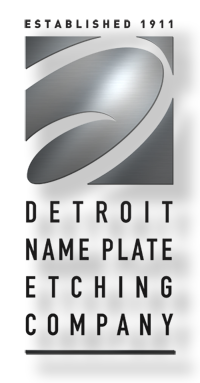The short answer is yes, but the real question is: what grade of stainless steel do you need for your name plates, data plates, or logo plates?
Classifying stainless steel
There are a couple ways to classify stainless steel: by type or by grade. Type has to do with the chemical compounds used to oxidize the iron and make it stainless steel, or the alloys used to make your steel more rust- and corrosion-resistant.
When it comes to treatment, there are a few main classes of stainless steel you should know about. Whether you call them families, classes, types, or grouping, temperature and materials are what distinguish stainless steel classes. The temperature changes the molecular structure of the steel, causing it to crystallize. They can come in tons of grades, but basically:
- Austenitic – The most common form of stainless steel, austenitic iron is heated to over 727 degrees centigrade and an alloy is added to it to it so it’s rust resistant. Austenitizing is specifically meant to bond to and crystalize with carbon and can’t be hardened more through heat treatments. It can be work hardened, meaning its hardness can be increased by hammering, rolling, or other forms of deformation.
- Martensitic – A carbon steel that’s heated and treated so it’s water resistant. Very common in surgical tools.
- Ferritic – This stainless steel isn’t as heated as austenitic steel. It’s less expensive than the former two classes since it doesn’t use as much nickel or need as much heat and can oxidize with less carbon. Nonetheless, it has corrosion resistance, is weldable, and is cost effective to produce.
- Duplex – A recent grouping, duplex was developed to combine the best of ferric and austenitic groupings. It’s highly customizable depending on the industry, so toughness and processes can vary.
Series 304 vs 316
A common argument in the stainless-steel world is, which grade of stainless steel is better: 304 or 316? Both are industry standard, but their different composition lends themselves to different types of projects.
The 300 series contains types of austenitic stainless steel. 304 is the most commonly produced stainless steel in the world, as it’s great for pipes, construction, and a ton of other versatile uses. However, it doesn’t stand up to corrosion as well as 316, so 316 tends to be used more in medical and chemical equipment. However, 316 has a higher price point, and for most uses, 304 has a comparable longevity and resistance to corrosion as 316.
Need help?
If you need help creating a stainless-steel name plate, data plate, logo plate, or more, let us know. We’ll gladly walk you through the types of stainless steel we use and how they can help your plates last as long as you need them to.
